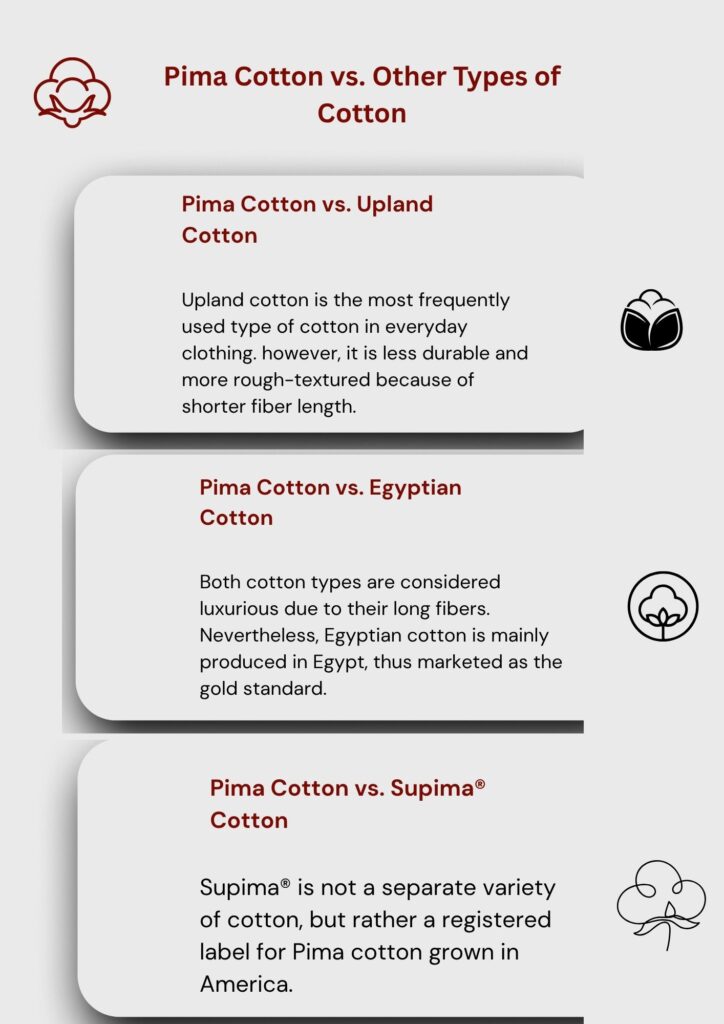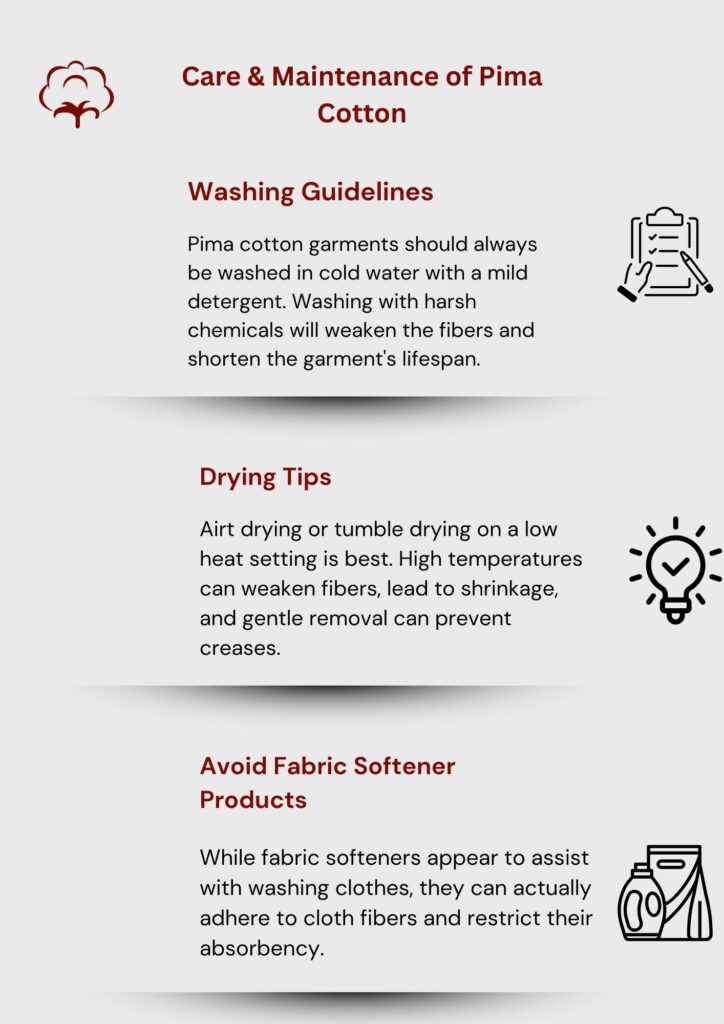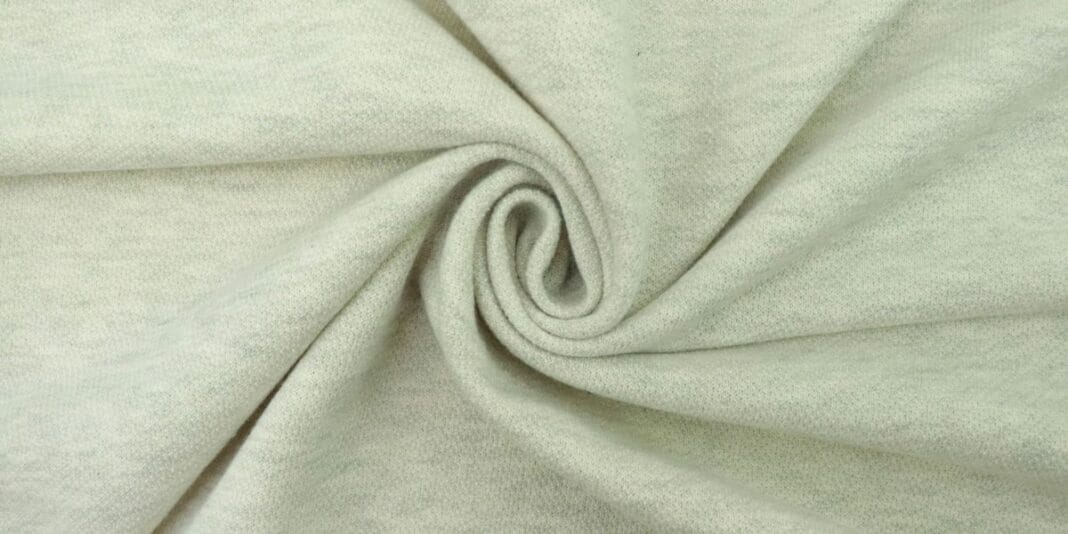Introduction
Cotto features extra-long silk-like fibers, remarkable strength, and a smooth texture and thus, qualifies as a luxury cotton. Today, it is regarded as the preferred material in premium towels and garments as well as in delicate fabrics. So, what is Pima cotton exactly? It is a natural fiber that elevates comfort to a whole new level.what is Pima cotton
To this classified group of fibers, “the soft and strong type” most definitely suits. The captivating durability associated with a Pima cotton fabric is due to the fact that it is woven from longer cotton fiber strands. Additionally, fewer ends will be exposed, so the resulting fabric is smoother and stronger. It indeed satiates the desire for luxury while standing true to the mark of quality.
The deal-breaker for most brands remains comfort; that much is fundamental to staying in the game. Upper-end brands have resorted to as a staple because of trust it instills, especially when compared to a more affordable counterpart. Brands can rest assured that their garments will stand the aegis of time unlike pervasive Upland counterparts that features shorter fibers, rougher textures and notorious reputation for wear.
Origins and History of Pima Cotton
Where Pima Cotton Was Initially Grown
The evolution of spans thousands of years and begins in Peru, where indigenous people grew extra-long staple centuries ago. The fiber later spread to the southwestern parts of the United States, which included Arizona, California, and New Mexico.
With the right amounts of heat and water, the arid climate provided exceptional growing conditions. Eventually, the United States was able to cultivate a better variety of this cotton, one which gained fame for its softness and quality.
The Name Behind the Fabric
Pima cotton is often compared to Egyptian because both are extra-long staple (ELS) varieties. This term means the fibers are longer than 1.4 inches, resulting in stronger, softer threads. Although they come from different regions, their quality is nearly identical, making them top-tier cotton options worldwide.
Pima Cotton and Egyptian Cotton: Long-Lost Cousins
Bothpima cotton and Egyptian cotton are compared to each other because they share the characteristics of being extra long staple (ELS) varieties. Fibers become stronger and softer threads if they exceed the length of 1.4 inches. While they are produced in different regions, the quality is almost the same
Features of Pima Cotton: Why It Is Considered Premium
Softness & Durability
Everyone would agree that one of the major features of is its sheer softness. The extraction of extra long fibers means that the surfaces of the fabric will always be softer. It gives a supple and luxurious feel which lasts for a long time. Such fibers also increase the longevity of the fabric, making it tougher against fraying and wear even after several washes.
Breathability & Moisture-Wicking Properties
People prefer fabrics especially in hot regions, as they are breathable. It is pima cotton’s ability to aid in moisture-wicking, sucking sweat away from the skin to keep you dry and comfortable throughout the day, that allows it to be especially useful for warm climate conditions.
Reduced Pilling Over Time
Pilling is the formation of small fluffy balls of fiber on the surface of fabrics, which is caused due to the weaker shorter cotton fibers breaking. Because of the longer fibers that has, pilling is reduced greatly. This means that the garment not only retains its aesthetics, but also its durability.Ordinal
Affordability While Maintaining Quality
What keeps many people away from Egyptian cotton is the price, which comes alongside a distinctiveness and quality. The avergae buyer will find much more affordable without sacrificing on luxury. It is this reason that earns it recognition in higher standard yet not ultra-prestige markets.
Pima Cotton vs. Other Types of Cotton

Pima Cotton vs. Upland Cotton
Upland cotton is the most frequently used type of cotton in everyday clothing. however, it is less durable and more rough-textured because of shorter fiber length. On the other hand, is smoother and more refined, making it better for high end use.
Pima Cotton vs. Egyptian Cotton
Both cotton types are considered luxurious due to their long fibers. Nevertheless, Egyptian cotton is mainly produced in Egypt, thus marketed as the gold standard. However, grown in the US rivals it in softness and durability, and often at a much lower price.
Pima Cotton vs. Supima® Cotton
Supima® is not a separate variety of cotton, but rather a registered label for grown in America. It assures unmatched fiber length, strength, and softness. As such, garnets saying Supima® will always contain trustworthy quality.
Benefits of Pima Cotton: Why It Stands Out
Exceptional Longevity
Pima cotton outlasts standard because it has longer fibers and a strong weave. When used in T-shirts or bedding, remains intact and retains its good appearance for multiple wash cycles.
Unmatched Comfort
Pima cotton slippers offer exceptional comfort which include unmatched softness and smoothness. Worn shirts, breeches, or while reclining on a Pima bedsheet, the fabric’s feel is second to none in terms of comfort.
Good for Sensitive Skin
Hypoallergenic cotton, as the name suggests, is bieng free from many things that can be harmful to people with delicate skin. falls under this category owing to its non-chemical, organic growing, and animal cruelty free nature, a person can experience lesser chances of skin-related problems.
Eco-Friendly when grown Sustainably
Pima cotton holds great promise of being eco-friendly as long as the cultivating methods are environment friendly. A number of United States farms growing Supima® cotton are claiming to use sustainable farming, restricting the use of water and chemicals on the crops.
Common Uses of Pima Cotton
Luxury Bedding
For individuals who relish the sensation of exceptionally polished and chill fabric against their skin love smooth, cool sheets. Fabrics with longer fibers are soft and silky.Pillowcases and duvet covers are great sleep enhancers and add luxury
Premium Clothing Items
High end apparel like fancy dresses, comfy underwear, and silky-soft t-shirts are made from they effortlessly mantain their shape and do not pill making them much more desirable compared to ordinary cotton clothes.
Bathrobes and towels
The absorbency and softness of Pima cotton makes it perfect for towels and bathrobes. These items feel thick and soft while effectively drying and remaining plush for countless washes.
How to Identify Genuine Pima Cotton
Look For Supima® Certification
Using the trademark logo is the easiest way to guarantee authenticity. Supima’s trademark certifies the cotton is Pima and 100% American grown, meeting the highest quality and performance standards.
Measure the Fiber Length
To be classified as genuine , the fibers must measure between 1.4 inches to two inches long. These longer fibers allow for finer, stronger yarns which makes smoother fabrics. Brands that advertise longer fiber length tend to be better.
Consider The Price Point
Products are usually expensive, and that is a good thing. The high price shows it’s quality. When it’s marked at suspiciously low prices, it’s probably blended with lower quality cotton or wrongly labeled.
Care & Maintenance of Pima Cotton

Washing Guidelines
Pima cotton garments should always be washed in cold water with a mild detergent. Washing with harsh chemicals will weaken the fibers and shorten the garment’s lifespan.
Drying Tips
Airt drying or tumble drying on a low heat setting is best. High temperatures can weaken fibers, lead to shrinkage, and gentle removal can prevent creases.
Avoid Fabric Softener Products
While fabric softeners appear to assist with washing clothes, they can actually adhere to cloth fibers and restrict their absorbency. Using gentle detergents and wool dryer balls to soften fabrics is far more effective methods.
Why Pima Cotton is Worth the Investment
Better Long-Term Value
Pima cotton does do an initial price dent in your pocket, but purchasing products means you’ll have them for a long time and need fewer replacements. This results in far more savings in the long run. The strength and durability of indeed offer a good return on investment.
Feels Amazing on the Body
Once people try, it becomes virtually impossible to go back to standard due to how comfy it feels. A Pima cotton’s silky texture makes everything from sleeping to daily wear more enjoyable.
A Sustainable Option
Pima cotton is ethically sourced and sustainably grown, making it a sustainable option. Farms by American Supima®, for instance, practice advanced water conservation, along with eco-friendly farming techniques.
Where to Buy Authentic Pima Cotton Products
Brands You Can Trust and Check Out
In case you don’t know where to look, here are some popular and trusted brands to start from:
- Boll & Branch – Luxury bedding and ethical sourcing.
Brooklinen – Long-staple cotton affordable luxury sheets.
Calvin Klein – Pima cotton apparel which ranges stylish.
Tommy John – Pima cotton underwear which is ultra-comfortable and known for.
What to Look For in Product Descriptions
Look for “100% ” or “Supima® cotton” when shopping. Do not pay attention to vague descriptions such as “cotton blend.” Where genuine products are concerned, description focus highlights the fiber length and certifications.
Conclusion
It is best to address the question “Is Worth the Investment” with a simple yes, this is because…
Pima Cotton does not only serve as a marketing term but is instead known as a natural fiber of great quality particularly when pitted against other standard types. T-shirts, towels, or even sheets made from Pima cotton allow for its users to feel an extraordinary texture that sets it apart from everyday items. Touching it brings a feeling of gentle luxury, and its uses transforms everyday items to experiences.
FAQs
It is used for making bath towels and premium undergarments, soft yet durable T shirts, dresses as well as luxury bedding. Also, it is common to find pima cotton in everyday comfort clothing as well as high end fashion.
Compared to regular cotton, like Upland cotton as an example, Pima Cotton possess greater benefits such as extra-long staple fibers which means it is softer as well as more durable.
Not exactly. Supima® is a trademarked brand derived from American-grown Pima cotton. All Supima cotton is Pima, but not all Pima cotton is Supima. Supima® guarantees the cotton is 100% U.S.-grown and has specific strict quality standards.


